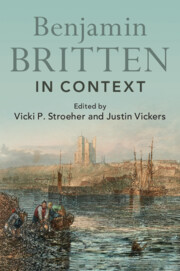Book contents
- Benjamin Britten in Context
- Composers in Context
- Benjamin Britten in Context
- Copyright page
- Dedication
- Contents
- Figures
- Tables
- Notes on Contributors
- Acknowledgements
- Bibliographic and In-Text Abbreviations
- Prologue
- Part I The Britten Circle(s)
- Part II British Musical Life
- Chapter 7 Composing in England
- Chapter 8 Britten and Film
- Chapter 9 Britten and the Radio
- Chapter 10 Recording a Musical Experience: Britten’s Works on Record and Television
- Chapter 11 Music Critics and the Press
- Chapter 12 Britten and English Opera
- Chapter 13 Festival Culture in the British Isles
- Chapter 14 Concert Life in Britain
- Chapter 15 Benjamin Britten and Folk Song
- Chapter 16 Educating the Nation
- Part III Britten and Other Composers
- Part IV Wordsmiths, Designers, and Performers
- Part V British Sociocultural, Religious, and Political Life
- Further Reading
- Index
Chapter 16 - Educating the Nation
Britten’s Music for Young People
from Part II - British Musical Life
Published online by Cambridge University Press: 31 March 2022
- Benjamin Britten in Context
- Composers in Context
- Benjamin Britten in Context
- Copyright page
- Dedication
- Contents
- Figures
- Tables
- Notes on Contributors
- Acknowledgements
- Bibliographic and In-Text Abbreviations
- Prologue
- Part I The Britten Circle(s)
- Part II British Musical Life
- Chapter 7 Composing in England
- Chapter 8 Britten and Film
- Chapter 9 Britten and the Radio
- Chapter 10 Recording a Musical Experience: Britten’s Works on Record and Television
- Chapter 11 Music Critics and the Press
- Chapter 12 Britten and English Opera
- Chapter 13 Festival Culture in the British Isles
- Chapter 14 Concert Life in Britain
- Chapter 15 Benjamin Britten and Folk Song
- Chapter 16 Educating the Nation
- Part III Britten and Other Composers
- Part IV Wordsmiths, Designers, and Performers
- Part V British Sociocultural, Religious, and Political Life
- Further Reading
- Index
Summary
This chapter explores Britten’s investment in composing for young people – the most obvious outworking of his well-known belief that the composer had a ‘duty to society’. It positions this part of his oeuvre within the context of a number of interconnected contemporary critical debates: about national education reform; about the supposed impact of sound reproduction technologies on the public’s listening habits; about the arts’ imagined capacity to nurture ‘responsible citizens’; and about the contested consequences of industrialisation for local culture and community. It then examines two different ways in which Britten responded to cultural critics’ concerns about the socially alienating conditions of modern life: whereas Noye’s Fludde sought to foster community through promoting amateur performance, The Young Person’s Guide to the Orchestra encouraged a different kind of cultural participation premised on ‘active’ listening. More broadly, these compositions reveal how arts education became a vehicle for debating, making sense of, and regulating the social changes that took place in mid-twentieth-century Britain.
Keywords
- Type
- Chapter
- Information
- Benjamin Britten in Context , pp. 136 - 144Publisher: Cambridge University PressPrint publication year: 2022

